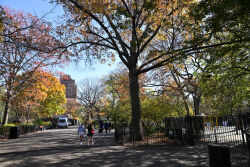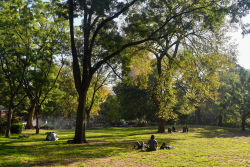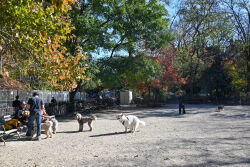Tompkins Square Park
Tompkins Square Park
What was here before?
The property was part of the largest salt marsh on Manhattan Island, used by the Lenape for hunting and fishing. Peter Stuyvesant (1610–1672), the last director-general of the Dutch colony of New Netherland later owned the land, part of a larger tract of swampland known as Stuyvesant Meadows and harvested marsh grasses for his cattle. The Commissioners’ Plan of 1811 (which defined placement of Manhattan’s streets and open spaces) proposed a vast market here that would stretch from First Avenue to the East River but plans never materialized.
How did this site become a park?
The square, first known as Clinton, was mapped in 1833 and renamed by the State legislature for former governor Daniel D. Tompkins (1774-1825). The City acquired Tompkins Square by condemnation in 1834. Swampland was filled, graded, and landscaped between 1835 and 1850. Gas lights were installed in the park in 1849. In 1851 a large fountain (later removed) was built in the park by the Croton Aqueduct Department, and the park was fenced in 1858. In 1866, the State Legislature ordered the City to remove trees and pave the square for use as a military parade ground for the Seventh Regiment of the New York State National Guard.
The New York State Legislature, bowing to pressure from city residents, redesignated the square as a public park in 1878, and it was redesigned the following year. Approximately 450 elm trees were planted, and many remain in the park today. The graceful layout of the park, with curving paths and oval plazas, was established then. The park also served as a place of public assembly and dissent in the mid-19th century. In 1857 “hunger meetings” were staged as citizens marched “for bread and work.” Protesters rallied in the park for work relief in 1873, and in 1877 the nation’s first railroad strike convened in Tompkins Square.
Performance was popular at the music pavilion, designed by Julius Munckwitz and installed in 1879. A reported fourteen summer concerts in 1899 (the pavilion was later converted to a restroom that survived into the 1930s). The Grecian-styled Temperance Fountain was erected in the park in 1888. A provisional playground was requested by the Park Board in 1894, and a playground for girls was built in 1904. A running track was laid out in 1905 and in 1911, 10,000 people witnessed here the City’s first inter-park athletic championships.
The surrounding community at that time was known as “Little Germany” for its preponderance of German immigrants. In 1904 a fire on a day excursion boat took the lives of more than a thousand local citizens. Their memory is honored by the poignant Slocum Disaster Memorial by Bruno Zimm, erected in 1906 by the field house in the northern precinct of the park.
An active children’s farm garden was launched in the park in 1930. In 1935-36 the Parks Department built a new playground, shuffleboard and paddle courts, a wading pool, horse-shoe pits, and a new playground. The park was again renovated in 1966 and installed a bandshell in the southern park that was used for many concerts and rallies in an era marked by the “counterculture”. An above ground mini-pool was installed in 1967.
In the late 1980s, police and East Village residents clashed after Parks began enforcing the park’s closing hours, in effect barring unhoused people from camping in the park. The park was closed in 1991 for a large two-year capital renovation. The bandshell was replaced in 1991 with a performance plaza, a dog run installed and new playgrounds rebuilt, several monuments conserved, and the turf and sidewalks replaced.
Who is this park named for?
This park honors Daniel D. Tompkins (1774–1825), who served as Governor of New York from 1807 to 1817 and as Vice President of the United States under James Monroe (1758-1831) from 1817 to 1825.
Tompkins was born in Fox Meadows, now Scarsdale, NY. His father was a farmer who fought in the Revolutionary War. Tompkins graduated from Columbia University in 1795, studied law, was admitted to the New York State bar, and entered politics soon after. In his last term as governor he initiated State legislation abolishing slavery which took effect ten years after he left office.
Check out your park's Vital Signs
Clean & Safe
Green & Resilient
Empowered & Engaged Users
Share your feedback or learn more about how this park is part of a
Vital Park System

Know Before You Go











